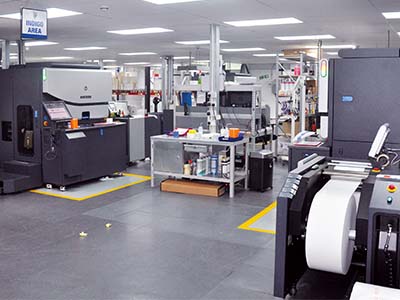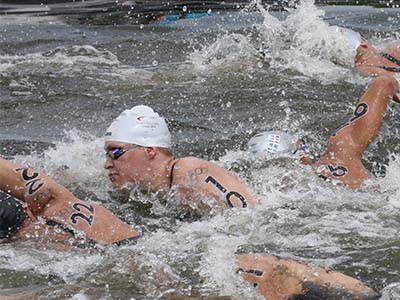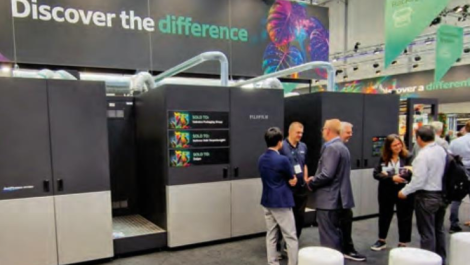Baker Labels offers a nice sideline in stickers for sports events under its Sportstiks brand – seen here in action at the Olympics 2012
Baker Labels is an innovative trade label supplier, selling to print management customers and other label producers, big and small, says Sean Smyth. He went to Brentwood, in Essex, to see the operation, which has just extended its digital capabilities and
One of the first companies in the UK to make the step into digital, Baker Labels has just completed a major upgrade of its digital capacity by buying and installing a pair of HP Indigo WS6800 presses. This makes three in total now operating alongside a Nilpeter FB-3 flexo press and a Screen Truepress Jet L350UV inkjet installed early in 2016. That was 10 years after the Essex-based company first moved into digital with its first HP Indigo press, a ws4050 in 2006. In 2008, the company added a ws4500, which was replaced by a WS6000 in 2009. Altogether, there have been seven orders for HP Indigo label presses, many of them firsts. In 2014, the company was the first UK user of the WS6800 press, five years after it installed the first HP Indigo WS6000 in the UK.
‘We came back after Christmas and I thought it was time to make the step. The company philosophy is to re-invest our profits and we talked to HP, placed the order and got the presses installed in a couple of weeks. It’s very exciting; the investment has really galvanised the staff and the company is buzzing’, said managing director Steve Baker.

There are now three HP Indigo WS6800 digital presses at Baker Labels
The two presses will provide new capabilities, with fluorescent pink (with blue and yellow to come), and an improved white. There will also be a new metallic series of inks that will open new applications. HP’s SmartStream Mosaic software allows every label imagery to be unique, but this has not yet been used for a commercial job, as customers learn the capability and benefits of the software. The new presses are not the only investment this year. The Nilpeter FB-3 flexo press is being upgraded with a rotary screen-varnishing unit to allow re-insertion, finish printed labels and add effects, including haptic or tactile varnishes.
Ahead of the game
Acting as a trade supplier places some interesting dynamics on the company. The new installations are designed to allow the company to react to customer demands more quickly, giving some headroom to provide premium service levels. The business depends on fast turnaround. Typical turnaround is four working days, and this is reducing, with a target of 48 hours from approval of artwork. It is notable that they see an increase in average run length, partly as customers invest in digital presses themselves to handle very short runs; Baker supplies what they can’t offer.
‘From the trade perspective keeping ahead of the game is always important,’ said Mr Baker. ‘Having new capabilities that we pioneer is one way of keeping our customers. Many of them don’t want to make investments in digital printing or embellishment, so we provide the service on their behalf. It means we have to be very flexible and quick to react, helping them provide the value that the end users need some of the time.’
The business has evolved and steadily grown over the years; today it turns over some £8 million (15% growth in the last financial year) with 60 people. Floor area has grown with an extended mezzanine; taking the services for the flexo machine upstairs released space on the production floor and there is still room for additional investment, which is definitely in the pipeline.
Staff growth has largely been in administration and sales support functions, developing the workflow and control of the internal system written around FileMaker Pro that provides a high level of control, including feed from cameras mounted over presses and finishing line, allowing remote viewing of activities in real-time. The company has invested in the system over the years and it suits the operation providing all the functions needed, including links to presses and finishing equipment for job tracking.
Is that really inkjet?
Two operators run the three HP Indigo presses. The work is organised so that one machine tends to handle the longer runs, with the other two shorter runs being regularly changed. When the new colours are available, it will be run on one of the short run presses, organising jobs on the most appropriate press. The presses are reel to reel, as is the inkjet machine, then jobs are passed to the finishing where the flexo press and a range of ABG Digicon converting lines provide a wide range of capabilities as needed.
The Screen inkjet press complements the Indigos. It is faster, with very good up-time, and according to Mr Baker, ‘Eats the work, with a very good white for clear and silver stocks.’ He commented, ‘It is also interesting to hear customers ask:’Is this really inkjet? The quality is too good for inkjet!’ and these are often label companies who don’t know what inkjet is capable of. We understand the benefits and are presenting the real capabilities, successfully.’
The press runs at 50 m/min in process colours and 30 m/min when using heavy base white, which is very good. The company is introducing fully variable capability on the machine, now able to print complex multi-page PDFs. The UV-cured ink has a much higher build than the Indigo result, more of a screen look than litho, with a very wide colour gamut, giving a high gloss, durable and lightfast result with great scratch resistance.
Baker Labels has learnt that inkjet is not quite plug-and-play, some substrates need to be primed and the press has web cleaning and corona discharge. As experience has grown so has press performance. Initially there were a couple of head replacements needed, but this is now much rarer, with a wide range of short and long runs being handled. Customers now include label converters with toner digital presses, which don’t have inkjet.
Niche sports brand
While most of the business is selling to the trade, there are some exceptions (and I don’t just mean the reels of labels supplied to the local vet on a quid-pro-quo basis for treating the family’s dog). Baker has developed a fast-growing niche brand, Sportstiks, to supply a range of bibs and numbers for athletes. The products are developing to produce temporary tattoos and hip numbers that print the numbers onto a natural skin look carrier for runners, cyclists and swimmers, using medical grade adhesives to make sure there is good durability and totally safe products.
It was originally developed because Steve Baker, a keen tri-athlete, could not get good competitor numbers and kit labels. This developed into a significant business, supplying into the 2012 Olympics and is now a selling into events globally with the forthcoming Islamic Solidarity Games in Baku during May using the products.
There are opportunities for race and event organisers to sell sponsorship and raise funds for the benefit of athletics clubs to promote the sport. Rather than just having a single number bib, the organisers could sell individual races to sponsors for local or televised events that could generate much needed funds and have the sponsor logo on the athletes as they compete. It has been a long gestation period, but www.sportstiks.com is now a very interesting website. It is also a significant part of the company’s growth and offers a route into totally new markets. Printed wearable electronics, for example?
On the trail
While the Sportstiks brand is offering a full web-to-print service for event organisers or individual competitors (and features Steve Baker in full running mode), offering web to label capability for the trade is still some way off. The complexity of the label in terms of materials, adhesive, finishing to run on a particular applicator makes it difficult to specify on a rules-based system. There is still a lot of value-added service provided by the label experts which remains an important part of the offer.
Keeping ahead of the market is the name of the game, and this is the task set for Labelexpo in September. Baker Labels will be on the acquisition trail again then, looking for ways to add value to labels. There may be a new finishing line, certainly new embellishment features with digital tactile and haptic varnishes on the shopping list. There is also security capabilities, with overt and covert track and trace capability being examined to let the label play its part in the growing anti-counterfeit sector that is helping the label buyers improve their business and comply with growing traceability legislation.
It does not take long to realise Steve Baker is a real label enthusiast, and he has built a very successful operation. He has one regret, however, ‘It’s that I am not 20 years younger. There are some fantastic business opportunities out there and the next 15 years are going to be really exciting.’ It is all about spotting opportunities and then exploiting them. And that is what Baker Labels is really very good at.






